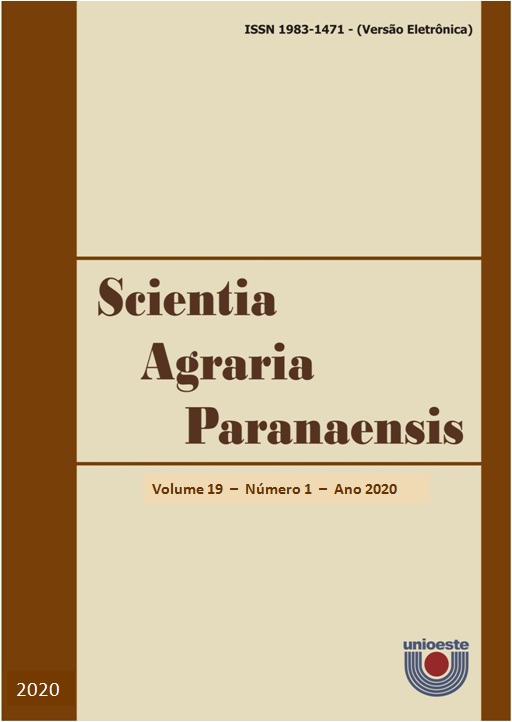Conduction systems in fig tree with two cultivars, evaluating fruits quality and yield
DOI:
https://doi.org/10.18188/sap.v19i1.23054
Agências de fomento
CAPES
Resumo
The fig tree is rustic and one of the fruit species with great economic importance, because it adapts easily to different climate and soil types. The objective of this study was to evaluate the influence the branches number and the fig tree cultivar on yield and fruit quality. The orchard implanted with two cultivars, Roxo de Valinhos and Pingo de Mel, and conducted with different numbers of productive branches, being: 16, 24 and 32. The utilized lineation was completely randomized, with three replicates, each replicate being composed of four plants. The analyzed variables were: branches length (cm), number of fruits per plant, number of fruits per branch meter, yield of mature fruits (Kg ha-1), yield of green fruits (Kg ha-1), accumulated productivity (Kg ha-1), fruit size (cm3), average fruit weight (g), soluble solids (°Brix) and fruit dry matter (%). The daily elongation rate and the mean length of the branches did not influence the different treatments. For productivity, noticed superiority on cultivar Roxo de Valinhos, with the higher the number of productive branches in the plants. Fruit quality, relative to soluble solids and dry matter, also did not influence the treatments. Fruits in larger caliber and size found from plants of the cultivar Roxo de Valinhos. Both for the production of fruits for fresh consumption and for the industrialization it is recommended the conduction with greater number of productive branches being between 24 and 32, for the greater productive yield.Downloads
Publicado
01-05-2020
Como Citar
ECKER, S. L.; LUGARESI, A.; GIRARDI, G. C.; LOUIS, B.; GALON, L.; GIACOBBO, C. L. Conduction systems in fig tree with two cultivars, evaluating fruits quality and yield. Scientia Agraria Paranaensis, [S. l.], v. 1, n. 1, p. 77–82, 2020. DOI: 10.18188/sap.v19i1.23054. Disponível em: https://saber.unioeste.br/index.php/scientiaagraria/article/view/23054. Acesso em: 15 out. 2025.
Edição
Seção
Artigos Científicos
Licença
Aviso de Direito Autoral Creative Commons
Política para Periódicos de Acesso Livre
Autores que publicam nesta revista concordam com os seguintes termos:
1. Autores mantém os direitos autorais e concedem à revista o direito de primeira publicação, com o trabalho simultaneamente licenciado sob a Licença Creative Commons Attribution que permite o compartilhamento do trabalho com reconhecimento da autoria e publicação inicial nesta revista.2. Autores têm autorização para assumir contratos adicionais separadamente, para distribuição não-exclusiva da versão do trabalho publicada nesta revista (ex.: publicar em repositório institucional ou como capítulo de livro), com reconhecimento de autoria e publicação inicial nesta revista.
3. Autores têm permissão e são estimulados a publicar e distribuir seu trabalho online (ex.: em repositórios institucionais ou na sua página pessoal) a qualquer ponto antes ou durante o processo editorial, já que isso pode gerar alterações produtivas, bem como aumentar o impacto e a citação do trabalho publicado (Veja O Efeito do Acesso Livre).
Licença Creative Commons
Esta obra está licenciada com uma Licença Creative Commons Atribuição-NãoComercial-CompartilhaIgual 4.0 Internacional, o que permite compartilhar, copiar, distribuir, exibir, reproduzir, a totalidade ou partes desde que não tenha objetivo comercial e sejam citados os autores e a fonte.


